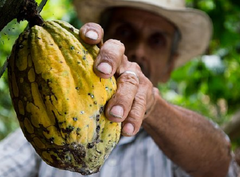Den Reichtum des Kakaos erforschen [06.03.23]
Kakao und die daraus entstandene Produktpalette sind bekannt für ihre reichhaltige und komplexe Natur, denn Kakao enthält neben Fetten und Proteinen eine Vielzahl an sekundären Pflanzenstoffen wie Polyphenolen, Methylxanthinen, Fettsäuren, Phenolsäuren, Vitaminen, Mineralien, Peptiden, N-Phenylpropenoyl-Aminosäuren, biogenen Aminen und mehr. Sowohl die Zusammensetzung des Kakaos als auch dessen Bioverfügbarkeit, Absorption und Stoffwechsel werden von verschiedenen Faktoren beeinflusst, z.B. der Genetik der Kakaopflanze, dem Terroir (der Anbau-Umgebung), der Verarbeitung und der Formulierung. Der Verzehr von Kakao und Kakaoprodukten kann potenziell gesundheitsfördernd sein, insbesondere bei hohen Flavonoidmengen. Die komplexen Zusammenhänge zwischen Kakaoverzehr und Gesundheit müssen jedoch noch detaillierter untersucht werden. In dem vorliegenden Buchkapitel werden die Zusammensetzung von Kakao und seine Veränderungen während der Nachernte- und Verarbeitungsschritte sowie der Zusammenhang zwischen der Zusammensetzung und den nachgewiesenen Metaboliten im Plasma und Urin nach dem Verzehr von Kakao untersucht. Auch werden physiologische Mechanismen mit besonderem Fokus auf die kardiovaskuläre Leistung diskutiert und Hinweise auf klinische Interventionen mit Kakao und Kakaoerzeugnissen gegeben.Originalpublikation
Abstract
Cocoa and cocoa derivatives are recognized for having a rich and complex nature. This is highly dependent on the cocoa genetics, on the terroir where cocoa is produced and processed, on the different transformation steps and on the final formulation of the product. Fats and proteins can constitute the highest percentage of different cocoa products, in addition a great variety of phytochemicals can be found, as for example, polyphenols as flavonoids, methylxanthines, fatty acids, phenolic acids, vitamins, minerals, peptides, N-phenylpropenoyl-l-amino acids, biogenic amines, among others. After intake, the bioavailability, absorption, metabolism, and excretion of these phytochemicals are mainly influenced by several factors as nature and dose of the phytochemicals, food matrix and interactions with other metabolites, subject profile and its overall health status and interactions with the microbiota. During these processes, a series of transformations lead to the production of metabolites which might exert biological activity with different implications. Increasing evidence shows that cocoa and derivatives intake has a potential role in health promotion suggesting acute positive effects over vascular parameters and cardiovascular performance, especially when containing significant amounts of flavonoids. Nonetheless, the relation between cocoa intake and health must be done with integrative approaches. This chapter aims to review the cocoa and cocoa derivatives composition, and its change during postharvest and processing steps. Furthermore, the relation between composition and metabolites reported in plasma and urine after intake of cocoa and cocoa products is shown. A review of some of the physiological mechanisms associated with the presence of metabolic products is addressed, with special focus on cardiovascular performance. Finally, evidence is presented regarding clinical interventions with cocoa and cocoa products, emphasizing cardiovascular health.
- Introduction
- Cocoa processing
- 2.1. Postharvest processing
- 2.2. Industrial processing
- Cocoa composition: main cocoa components and their dependence on processing
- 3.1. Other phytochemicals
- Bioavailability and metabolism of cocoa phytochemicals
- Cocoa phytochemicals and cardiovascular performance: Biochemical and physiological-associated mechanisms
- Clinical interventions with cocoa and cocoa products: addressing cardiovascular performance
- Closing remarks
- References
© 2023 Elsevier Inc. All rights reserved.
Mehr zum Autor und dem Fachgebiet für Biofunktionalität der Lebensmittel
 | Dr. Alexander MONTOYA ARROYO
Postdoc |
 | Prof. Dr. Jan FRANK
Lehrstuhlinhaber |


